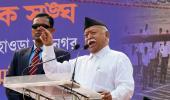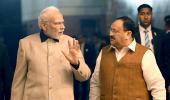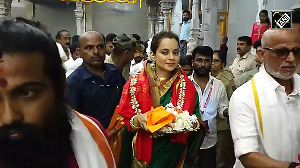The BJP at 43 is a work in progress, with total ideological continuity and much substantive change in political method and style, observes Shekhar Gupta.

The BJP's 43rd birthday -- or rather, rebirth day as L K Advani preferred to call it, especially because it was founded on the Easter weekend in 1980 -- saw much written about the party around which all of India's politics dances.
The more important landmark, however, is that the party's second consecutive government is entering its last year.
By this time next year, a couple rounds of voting will have already taken place.
As things stand today, despite all the frenetic activity on the part of the Opposition, the BJP would look to be in a near-impregnable situation.
This isn't a privilege it ever had under its founders.
It is still very much the party they had founded from the ashes of the Janata Party, but much has changed and evolved under Narendra Modi, Amit Shah, and now J P Nadda.
It's a good time to see how similar this 43 year old is to the party Mr Advani and Atal Bihari Vajpayee founded, and how it has changed.
The first thing that hasn't changed is ideological cohesion.
The founders stayed mostly true to the RSS, (let's say Sangh) ideology.
While they drew in much talent from outside, as the Modi-Shah team has done under National Democratic Alliance-II, the top party leaders all came from the same ideological nursery.
This includes the presidents, key general secretaries, even most (not all) of the state chiefs.
This leadership is equally close to the ideas of the RSS.
There are many differences too, though you could argue that these also reflect the reality of numbers as the founders never had a majority.
The need to keep a diverse coalition together meant they had to put some of the essential elements of their ideology on the back burner -- the special status of Kashmir (Article 370), the Ram temple, and the Uniform Civil Code being the most prominent.
Their successors won a majority and realised the first two quickly. The third is being done through salami-slicing.
Triple talaq was the beginning; the minimum age of marriage and polygamy, we can be sure, are on the way.
The fact that the founders recreated an ideological party subsumed and lost in the 1977 Janata Party experiment is creditable by itself.
Of the five major constituents that merged to form the Janata Party -- the Bharatiya Jana Sangh, the Indian National Congress (Organisation), the Socialist Party, the Bharatiya Lok Dal (led by Charan Singh) and Babu Jagjivan Ram's Congress for Democracy -- there was just one that not only survived but emerged in a new avatar. That was the BJP.
All others fell by the wayside and some elements morphed into state-specific, caste-based parties (via the Janata Dal), such as the Samajwadi Party (Mulayam) and the Rashtriya Janata Dal (Lalu).
The Socialists were finally reduced to George Fernandes and now Nitish Kumar's Janata Dal-United in Bihar.
The Janata Party's fate is truly summarised in that immortal 1948 duet in the voices of Mohammed Rafi and Suraiya: 'Ek dil ke tukde hazar huye, koi yahan gira, koi wahan gira (this heart broke into a thousand pieces and scattered across the land).'
Only one of these parties pulled itself up and now rules us with power without comparison in our history.
Not even in Indira Gandhi's heyday. And a clear ideology was a big reason the Jana Sangh was reborn unscathed as the Bharatiya Janata Party.

If ideology was such an effective glue, it was also baggage as it deterred others from joining hands, much as they all detested the Congress and the Gandhi dynasty.
That remained the BJP's biggest challenge.
And if Messrs Modi and Shah are so successful now, they need to thank the founders, especially Vajpayee, for ridding the party of its untouchability in the Opposition space.
The big move was offering support to V P Singh's government to deny the Congress under Rajiv Gandhi power, although it was by far the largest party.
It isn't a political event adequately appreciated now, but the BJP's support -- even if short-lived -- to a Left-leaning combination was so sharply at odds with its own ideology that it began the dilution of that untouchability.
It was also realpolitik, as the best way to weaken the Congress was to keep it away from power.
How much of a challenge it was is evident from the anti-BJP coalitions the Congress later helped in power, from Chandra Shekhar (1990-1991) to H D Deve Gowda and I K Gujral (1997-1998).
It was very simple to justify that on the argument of keeping 'secular' forces together and 'communal' ones out.
For Mr Advani and Vajpayee, to make common cause with some of the same forces subsequently was a much bigger achievement.
Mamata Banerjee, Chandrababu Naidu, Naveen Patnaik, Ram Vilas Paswan, and the Abdullahs of Kashmir, among others, joined their coalition besides their natural allies such as the Shiromani Akali Dal and the Shiv Sena.
That ended their political untouchability.
The difference now is that the BJP has become so powerful by itself that it does not need any of these allies.
Not even the Akalis and the Shiv Sena. They dumped one, broke the other.
It may make some local and opportunistic arrangements with tiny caste-based parties, especially in the heartland, but it depends on none.
Two exceptions are the All India Anna Dravida Munnetra Kazhagam and Eknath Shinde's Shiv Sena.
But let's watch how durable the Shinde Sena's prospects are. Maybe by the time we are writing something on the BJP's 45th birthday.
If, from having to worry about being untouchable for likely allies, the BJP has risen to a place where it can't be touched by any rival, the incumbents have also made some major departures from the ideas they inherited. You could call it evolution.
First of all, the party now has an almighty personality cult. Which is something it stood against in the Indira era ('Indira is India').
In the Vajpayee-Advani period, power was shared between the two and others, especially the RSS, had a say -- often in disapproval.
Now the RSS fully endorses the government and celebrates all its actions.
You could, of course, argue that if the government is delivering so fully on its ideological concerns, why should the RSS be complaining?

The next is the basic approach to politics. The founders could play hardball, but Vajpayee often said 'rajneeti sauda nahin hai' (politics isn't transactional).
Their successors have perfected their own version of transactionally uncluttered politics.
Vajpayee built a strong, centralised prime minister's pffice and the RSS routinely questioned it.
The Modi PMO is enormously more powerful, and nobody is complaining.
It helps that the party does not need to give any space to an ally.
The Vajpayee government, we should note, had at least one ideological outsider (George Fernandes) in his Cabinet Committee on Security.
Among the many things the founders started was a search for younger talent.
In January 1984, when the party had been reduced to two seats in the Rajiv wave, I interviewed Vajpayee for a cover story on India's battered Opposition.
He acknowledged that youth was one of Rajiv's strengths and that he was looking for younger leaders.
He mentioned Arun Jaitley and Pramod Mahajan.
The fact is, many of the younger leaders identified in the founders' era are now leading the party. These include Narendra Modi.
How does the current leadership's report card compare with the founders on this human resources metric? Do we see the rise of the next generation of leaders? There are some, like Himanta Biswa Sarma, Yogi Adityanath, maybe Devendra Fadnavis -- perhaps not as wide a catchment as under the founders.
The BJP at 43 is a work in progress, with total ideological continuity and much substantive change in political method and style.
Whether you like it or not, of course, depends on where you are coming from.
By special arrangement with The Print












 © 2025
© 2025